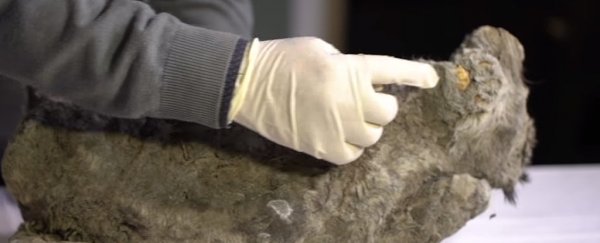With its head resting on its paw, the remains of a cave lion cub found frozen in Siberia could have been sleeping in the permafrost for up to 50,000 years.
The little animal was so perfectly preserved, one could make out its facial features and even the toes on its paws - and the discovery has sparked new discussion over cloning these long-extinct cats.
The remarkably intact remains were found on the bank of the Tirekhtykh River in the Abyisky district of Yakutia by local resident Boris Berezhnov. Scientists unveiled the discovery in Yakutsk on Wednesday.
It's not clear how the lion died, but it was around one-and-a-half to two months old, and it probably perished sometime between 20,000 and 50,000 years ago, scientists said - before the end of the last ice age in the late Pleistocene, which took place around 11,700 years ago. This was also around the time the cave lion became extinct.
'It is a perfectly preserved lion cub, all the limbs have survived. There are no traces of external injuries on the skin," said Sakha Republic Academy of Sciences palaeontologist Albert Protopopov.
The lion is small, just 45 centimetres (17.7 inches) long and weighs 4 kilograms (8.8 pounds).
Its preservation can be attributed to the permafrost, a layer of ground permanently below freezing temperature. It's not the first time permafrost has yielded incredibly well-preserved ice age remains, or even ice age cave lion remains.
In 2015, the remains of a pair of cave lion cubs, just a few weeks old, were discovered in the permafrost of the same region, but in the bank of a different river, the Uyandina.
Named Uyan and Dina, the cubs were not yet old enough to have grown teeth, and later analysis revealed that they were somewhere between 25,000 and 55,000 years old.
Even more tantalisingly, a CT scan revealed that the stomach of one of the cubs could have retained traces of its mother's milk.
"Everyone was amazed then and did not believe that such a thing is possible, and now, two years later, another cave lion has been found in the Abyiski district," Protopopov said.
The new lion, yet to be named, is not related to the first two, scientists said.
"The cub was found on the river Tirehtakh, it is in a different locality, and it is obviously larger and older than Uyandinsk lions, so they are from different litter," Protopopov said.
Because it was old enough to have teeth, the exact age of the new cub may be easier to determine. The amino acids in the dentine can be analysed to narrow down a more precise time for the lion's life and death.
When Uyan and Dina were discovered, scientists around the world expressed interest in a project to clone a cave lion from samples taken from the cubs. The new discovery has renewed discussion about that possibility.
And it's not totally unfeasible - in 2008 researchers cloned a mouse from the deceased remains of one that had been frozen for 16 years.
There are some significant differences between remains that have been frozen for over 20,000 years and remains that have been frozen for 16 years, but that may not be the biggest barrier.
Whether or not it's ethical to bring extinct species back from the dead is a topic of hot debate among scientists. On the one hand, it would be amazing to see and study a living woolly mammoth, for example.
On the other hand, we don't know how we'd reintroduce the species to the world, what effect they would have on modern ecosystems and, conservationists argue, we should be using our resources on species that are endangered now.
Either way, a cloning attempt may be some time away. In the meantime, Protopopov and other scientists will conduct further analysis on the cub's remains, hoping to determine its age, its sex, and how exactly it died.
You can see more photos of the find over at The Siberian Times.
